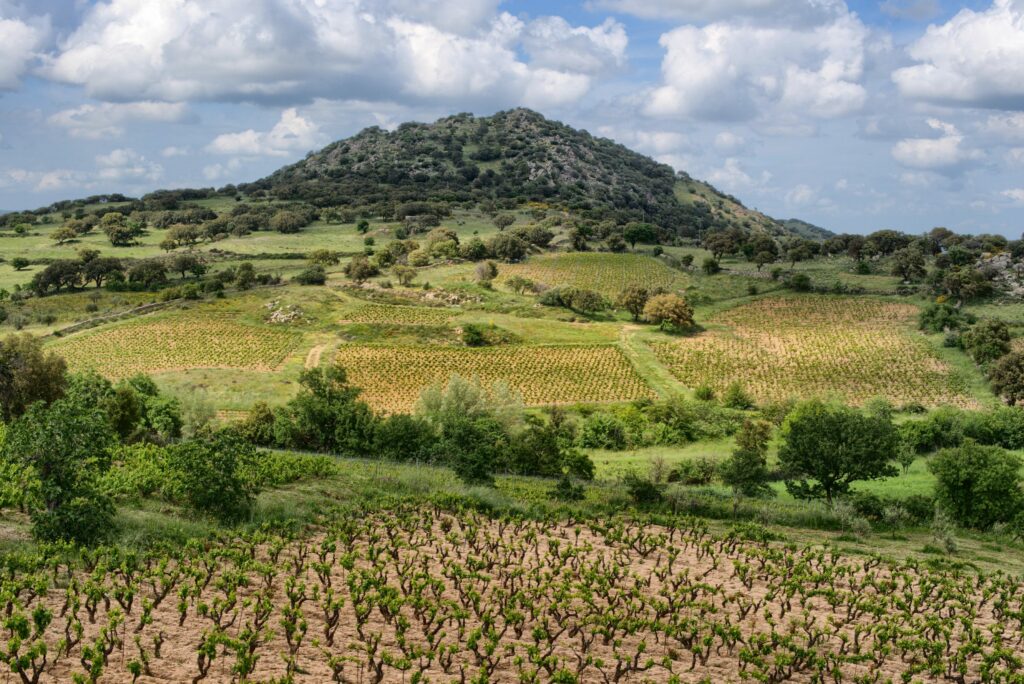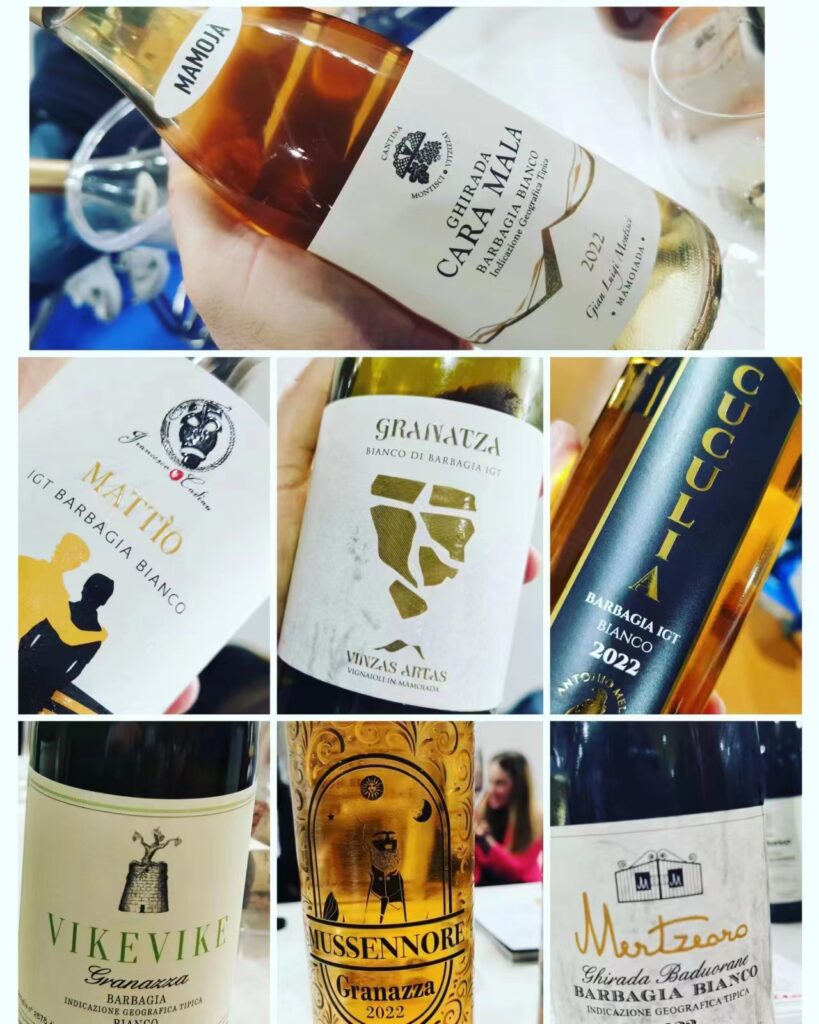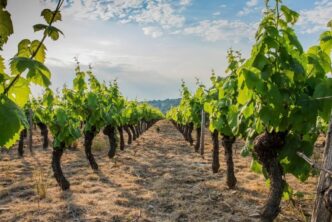Years ago, when still writing for Stephen Tanzer’s International Wine Cellar, I described wines made with the Granatza variety, a very rare native white grape of Sardinia that still today has not yet been the subject of an in-depth look in an English language wine magazine. Much like Piedmont’s Nascetta and Friuli Venezia Giulia’s Tazzelenghe (both subjects of upcoming in-depth reports by me here in the TerroirSense Wine Review), Granatza is a variety that takes being a “native grape” to a whole new level. For example, there are native grapes that are typical of just one country (and Italy is literally bursting at the seams with them); then there are native grapes that are common to only one region or province within that country (and Italy is chock-a-block with those too); but some native grapes are rarer still, found only in specific areas of one region or province, which is the case of Granatza.

Granatza is native to Sardinia, one of Italy’s twenty regions and one of its most magically beautiful; and like Sicily, it is an island. And quite a noteworthy island at that: it is the second largest island of the Mediterranean Sea and at 23,949 square kilometers, the eight-largest island of Europe. It is even more interesting from an historical, social, and viticultural perspective, given that probably Sardinia is home, by many scientific estimates, to about eighty to one hundred native grape varieties that have not yet been identified. For example, people routinely speak of Sardinian wines made with the “Monica” variety, blissfully unaware that there are probably at least four, if not five, different grapes all called “Monica” on the island. Clearly, grapes that live in different parts of the island and that give different wines. Those wines aren’t different because of some magical “terroir” or winemaking mumbo jumbo, but because the grapes are fundamentally different.
As we shall see, the same applies to Granatza, or Granazza, as it is also called. Granatza appears to have lived on Sardinia’s soil for centuries, where it has been documented under slightly different names. The grape’s name is a derivation of “guarnaccia”, in itself a derivation of the Latin term vernaculum, meaning “local”, as in a very generic “local grape variety” (that’s why there are “Vernaccia” grapes found all over Italy, but that is colloquial term and more often than not the official name those grapes should go by). Granatza is a variety that is especially typical and native of the Mamoiada commune and its territory. “Mamoiada” is the name of a town in central Sardinia, and its name has been postulated to have a number of possible origins. One interpretation is that “Mamoiada” derives from ancient Phoenician, or perhaps Greek, or perhaps Roman words. The Greek origin has mamoiada stemming from “I am called mother”; the ancient Roman origin harkens back to (statio or manso) manubiata, meaning a “guarded station or fort”, because of a permanent Roman military camp in the area; while the proto-Sardinian hypothesis is that mamoiada was taken from one or possibly two different fountains in the town, one called su Quanturu Vetzu and the other, located in the lower part of town in the San Giuseppe quarter, that was called Mamujone. In ways that I do not believe are particularly clear (yet) to anyone I know of, researchers included, these names morphed into Mamoiada over the centuries; in this respect, it is not without interest that ancient local masks used for celebrations and/or religious activities were called mamuthone, maimone, mamoiada, and/or mannau, all of which referenced ancient divinities of rain and water. [And in this light, it is just as interesting to note that in centuries past, in periods of drought, the religious custom in various Sardinian towns hoping and asking for rain was to parade around the town carrying a simulacrum (a simulacrum is an image or representation of something or someone, such as a caricature) called a maimone.]
Mamoiada is a small town boasting a little less than 3000 inhabitants, situated in the province of Nuoro at about 640 meters above sea level within the Barbagia di Ollolai area of Central Sardinia. Do note that while the main town is located at an altitude of 640 meters, the commune’s territory ranges from 390 meters to 1080 meters above sea level and extends for close to fifty square kilometers. It is a part of Sardinia heavily devoted to raising farm animals, but also to viticulture. The Mamoiada territory’s vineyards are commonly planted at and well above 600 meters above sea level (up as high as 1000 meters), meaning the area is characterized by a mountainous habitat and viticulture. The area has always been especially famous for its unique, and uniquely good, Cannonau wines (that can be labelled as Cannonau di Sardegna or Barbagia Rosso, for example). The good news for all wine lovers out there is that now another local grape variety is coming to the fore: Granatza, or Granazza. Wines made with it belong to the Barbagia Bianco or Bianco di Barbagia category, but mercifully that name, which means very little to anyone living outside of a stone’s throw of the place, is helped out by most producers intelligently sticking the word Granatza (or Granazza) somewhere on their front and/or back labels.
Granatza, the grape variety
According to Gianni Sedilesu, one of the area’s most respected wine producers, while Granatza has been found in a few sporadic rows or individual plants here and there all over Sardinia (for example in the territories of Oliena and Orgosolo), it was the farmers of the Mamoiada region of Sardinia that alerted scientists such as Gianni Lovicu to the grape’s existence. Lovicu and the growers of the Mamoiada collaborated together on deepening everyone’s understanding and knowledge about the variety. Today the Mamoiada grower’s association has two officially certified Granatza vineyards from where the association’s members can buy grapevines to plant their vineyards with.
But much like my earlier Monica example, not all Granatza-named grapes growing in Sardinia are probably really all the same “Granatza”. By way of the studies conducted by the AGRIS Sardegna (the Sardinian regional entity entrusted with the role of performing agriculture research on the island through the Akinas project) and conducted with the input of the Mamoiada producers association, we know a little more than we once did about Sardinia’s Granatza. It appears that “Granatza” varieties have been identified in other parts of Sardinia, including the territories of Orgosolo and Oliena, but they are much less common there than the grape is in the Mamoiada. Furthermore, much like my earlier Monica example, those grapes appear to be different varieties from the Granatza of the Mamoiada. There is also a Guarnaccia variety in Calabria which is genetically similar but not exactly like the Mamoiada’s Granatza variety (as mentioned previously, “Guarnaccia” in Italy is a name commonly associated with local grapes – so there are numerous so-called “Granatza” or “Guarnaccia” grapes all over Italy, all of which are essentially unrelated, because, as previously mentioned, the word derives from the old Latin term meaning “local”, in this specific case as in “local grape variety” and nothing more than that).
In any case, the Calabrian variety gives a different wine from that of Sardinia; furthermore, said Calabrian Guarnaccia variety is no longer that common in the region (and to the best of my knowledge there is only one producer vinifying it as a single variety wine). By contrast, in the Mamoiada territory, Granatza has grown in importance and relevance (rather than becoming an also-ran), because producers there, who wanted to make a 100% Cannonau red wine, took to picking and vinifying their Granatza grapes on their own. But in so doing, they became quickly aware of the high winemaking potential their white variety is endowed with. The Calabrian and Sardinian varieties of Granatza/Guarnaccia have different morphologic appearances and give different wines, such that they can be considered to be, at the very least, two biotypes of the same variety, if not altogether different varieties. Besides, the history of ampelographic identification is rife with errors made, a problem compounded by those who talk and write about wine citing pseudo-scientific information gleaned from sources drawing conclusions that have never been published in truly scientifically valid, peer-reviewed journals.
Currently, there are fifteen hectares planted to Granatza in the Mamoiada territory and ten producers making monovariety wine with it, even if only in extremely small numbers (on average, from 600 bottles to 2,000 bottles per year). However, both those numbers are expected to rise sharply in the next few years as basically every producer in the area is planting at least some Granatza. The majority of new vines all originate from a very old massal selection from the Giuseppe Sedilesu estate and their Ghirada Garaunele vineyard (a ghirada is the word used in Mamoiada to describe a cru, or a vineyard area of specific high quality and somewhereness). I have rarely met so many producers in such a small area who are as hell-bent on planting one specific grape as the Mamoiada’s producers are when it comes to their Granatza: there’s an unbelievable sense of pride and faith in doing so that is really striking. However, as historically Granatza was co-planted amidst vines of Cannonau, pure monovariety vineyards of Granatza are still rare: in order to make their white wine, most of the Mamoiada’s producers still have to resort to searching for the white Granatza berries amongst the red Cannonau ones. What this means is that there are many extremely old vines of Granatza from which to source grapes (some as much as 120 years old); by contrast, the majority of the Granatza monovariety vineyards are currently five years old or less. In fact, many of the Mamoiada’s wineries will be producing their first Granatza wine only in the next year or so; after all, the rush to plant this variety is a relatively recent one.
Typically, Granatza is characterized by small to medium-sized, loosely-packed bunches that are roughly cylindrical to pyramidal in shape; the grapes are also small, and round; here is also a rarer subset of Granatza vines that have tightly-packed bunches and also atypical medium to medium-large round grapes (instead of Granatza’s usually small-sized grapes). All Granatza grapes have skins that are thick and resistant, and that are of a typical green hue until they reach full ripeness, at which point they turn bright yellow and even brown when left to air-dry on the vine (when the goal is to make dessert-style wines). The old plantings are either ungrafted or on Rupestris rootstocks, while the rootstock of choice for new plantings is the 1103 Paulsen, because of the area’s highly draining granite soils and because of the rootstock’s deep-rooting capacity to drive roots down deep such that the roots may, among other advantages, find water with greater ease. (In light of the concerns relative to drought, always a possibility in parched Sardinia, the key might be to evaluate returning to a more widespread use of the rustic Rupestris rootstock.) Granatza is a generally resistant variety to common diseases, especially to powdery and downy mildew (more resistant to both those pests than Cannonau, for example) and to windy conditions, while drought and late spring frosts can pose a problem (its bud-burst occurs relatively early in the growing season). The soils of the area are all of disaggregated granite (clay is generally rare in this part of Italy, save for the aforementioned Garaunele cru and in a few other small pockets): the hillside slopes are best for making more concentrated, classically dry and dessert wines of higher quality, while the lower-lying areas characterized by deeper, more fertile soil are most suited to making lighter, easier-going wines that are lower in alcohol and of easy approachability. However, it is not so cut-and-dried: for example, the best soils for Granatza might turn out to be the slightly more fertile ones. After all, it gives one pause to think that the old Granatza vines that are still alive in field blends out there are all generally planted in richer, lower-lying soils, which to my mind may have one of two meanings: either that such soils are really the best possible place for the Granatza to grow in or that it was viewed as a rustic grape -which it undoubtedly is- that could produce larger amounts of wine. In this second case, it would make sense to plant Granatza where it might produce more. Only time will tell where the truth lies (I trust you grasp that the “lower-lying” bit instead holds little if any interest, given that climate change was not a problem a century or so ago, and warmer areas might have been back then the best in which to plant any grape in, never mind one as early budding like Granatza).
According to most people I have interviewed and visited over the years, as well as my tastings of the last six-ten years, Granatza has a bright future ahead of it, if for no other reason because of its versatility: it can give an excellent dessert wine (for example, Cantina Sedilesu’s Perda Pintà wine has already reaped numerous awards and high scores) but thanks to its acidity and structure, it can also give delightful sparkling and classically dry white wines. Most producers are still learning as they go, and for the time being Granatza winemaking is fairly straightforward: though there are some exceptions (meaning aging in oak and other vessels and slightly increasing skin contact), almost all Granatza wines today are made by fermentation with native yeasts in stainless steel tanks; aging is also done, for the most part, in stainless steel tanks. It follows that most Granatza wines made today are lemony-fresh and juicy, and very approachable in their eminently thirst-quenching appeal, but the grape has the potential to give different kinds of wines. This tasting report is, to be crystal-clear, the first in-depth and largest published to date in an English-Language wine article and is but one in a long line of work devoted to Italy’s native grapes and wines that I have dedicated myself to for the past twenty-plus years.
It is a report that showcases just how Granatza the grape, and Granatza the wines, really do have the potential for a very bright future ahead.

The wines in this tasting
All the wines in this report were sourced from the wineries and tasted in Italy in April during my stay there.
Antonio Mele 2022 Granatza Cuculia Barbagia Bianco 93
Luminous straw-green. Aromas of apple, pear, fresh citrus fruit, white flowers and mint. Then similar flavours on the palate, with wonderful clarity and cut brought to the fore by harmonious, zingy acidity. Finishes long and bright, with sneaky amounts of concentration and complexity. A very refined wine that might get lost in blind tastings if placed between two oaky behemoths, but there’s a lot of wine here providing a shining example of just what the Granatza variety can deliver. Well done. The grapes are picked in a 1.5 hectares vineyard and the 2022 is the first vintage; only 1700 bottles were made but the estate hopes to make 6-7,000 a year when all their vines go into production. Stainless steel, natural yeast- fermented and also matured in stainless steel tanks, with no malolactic talking place. Drinking window: 2023-2026. Mele selected his Granatza vines from an 80 years old vineyard owned by his friends at the Mulargiu estate and propagated by a nursery he has been working with for years. The soils here are especially rich in zinc and there’s a large presence of wild mint growing around the vines, which, for what its worth, is a descriptor I associate with Mele’s wines. Drinking window: 2023-2026.
Cantina Montisci Vitzizzai 2022 Ghirada Cara Mala Barbagia Bianco 92
Bright medium straw yellow. Perfumed aromas of lime, jasmine, hay and apple. Lively and juicy in the mouth, with well-delienated flavours that echo the aromas. The aftertaste is long and juicy, and features a nice saline nuance. The production of Granatza wine at Montisci is still lilliuputian: originally the winery only had a few old vines of Granatza dispersed through an 80 years old, 0.6 hectares large Cannonau vineyard (only 2% of which was planted to Granatza, or fifty grapevines) but in 2018 they selected some old Granatza plants such that they were then able to propagate 600 vines replanting them at about 720 meters above sea level, facing southwest. The wine is currently stainless steel-fermented and aged, but the winery is currently experimenting aging Granatza wine in old small oak 225L barrels too. Drinking window: 2023-2026.
Francesco Cadiniu 2022 Mattìo Barbagia Bianco 92
Vivid straw-green. Tangerine, lemon, apple and nectarine dominate the nose and palate, with a steely-like personality and tautness lingering nicely on the long zippy close. A very clean, almost Germanic styled wine that provides lots of thirst-quenching flavour. Drinking window: 2023-2026.
Mertzeoro 2022 Ghirada Baduorane Barbagia Bianco 92
Bright pale yellow. Captivating aromas of white peach, ginger, minerals and minty herbs. Juicy and intense, with lovely perfumed lift to the flavors of peach, white pepper and ginger. Finishes strong, tactile and long, with vibrant saline and herbal notes. Classic, energetic Granatza wine that combines sound acidity and full ripeness. Mertzeoro is one of the biggest owners of Granatza vines, boasting two hectares planted to the variety (one vineyard has 6200 vines and was planted ten years ago; a second vineyard has 3800 vines and was planted three years ago). The wine is stainless steel-fermented with no skin contact. Drinking window: 2023-2026.
Mussenore 2022 Granazza Barbagia Bianco 92
Bright, pale yellow. Lemon oil, flint and a whiff of minty reduction on the nose. The palate begins with almost a sweet impression, but there’s terrific energy and tension to the classically dry flavours of liquid rock and orange blossom. Closes long, with superb lift and length. About 700 bottles made of this wine, the estate’s first vintage ever of Granatza wine. Currently they make the wine by buying grapes from two of their mamoiada colleagues and friends, but have moved to work with a nursery so as to be able to plant in 2024 roughly 5-6000 Granatza vines in a one-hectare vineyard they own. The wine is stainless steel-fermented and aged but the estate is experimenting with other types of aging vessels too. Drinking window: 2023-2026.
Vinzas Artas 2021 Granatza Bianco di Barbagia 92
Vibrant straw-yellow. Very inviting, precise aromas of lemon, orange oil, wet stone and spicy herbs. Juicy, delicately herbal and tight, with a firm acid backbone. Turns more peachy on the long fresh finish. The winery owns one hectare of Granatza vines planted six years ago, plus numerous very old vines that are co-planted among similarly old Cannonau vines. They made a “whopping” 750 bottles of the 2021 Granatza and look forward to making 900 bottles of the 2022 vintage (with still more in the years to come, hopefully, given that they planted 2000 Granatza vines in 2019 in the Su Pinu area and another 2000 this year in the Garaunele area). Drinking window: 2023-2026.
Vikevike 2022 Granazza Barbagia Bianco 91
Straw-green colour. Aromas of white flowers, minty herbs, and fresh citrus fruits. Fresh on entry, then turns lush in the middle with orange peel and mineral flavors rising. The exotic quality carries through to the long, firm back end. Another thirst-quenching Granatza wine but with more complexity and concentration than is apparent at a superficial taste. Drinking window: 2023-2026.

 English
English



